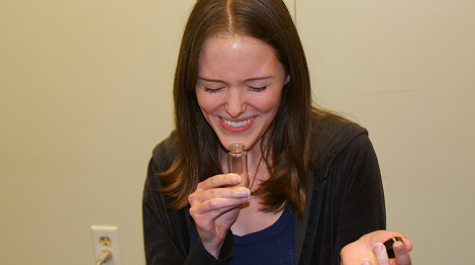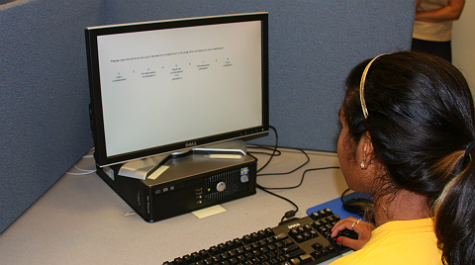Collaborative research yields new insight into perceptions of homosexuality
That miserable standing ride in a crowded subway car, pushing your headphones deeper into your ears to drown out the screaming baby and being bounced into your neighbor with every jarring turn, is a familiar experience to anyone who’s been to a large city at rush hour. Everybody seems to become a potential nuisance once you enter the underground line’s dank reek.
But have you wondered what it would be like if you encountered the same people while hiking in the fresh mountain air? Somehow, that negative outlook seems to fade.
A team of William & Mary researchers explored this phenomenon in a study published in June, discovering that situational variables—like the subway car’s ambient stench—have a measurable but subconscious effect on how people perceive gay and lesbian couples, influencing their opinions without their awareness.
The study, published online in the European Journal of Social Psychology, brought together a unique team of researchers to delve into the science behind this polarizing issue. Associate Professor Catherine Forestell and Assistant Professor Cheryl Dickter of William & Mary’s psychology department joined forces with Emily Cunningham ’11—the study’s lead author—to use a technique called odor manipulation to induce disgust in participants and observe its effect on their perceptions of homosexual couples.
The findings of the team—a collaboration Forestell describes as “a match made in heaven”—promise to provide needed insight into an intensely politicized topic.
The methodology of manipulation
After reviewing earlier studies using odors to induce disgust, Forestell and Dickter devised a new research approach to answer the question: Does induced disgust affect implicit as well as explicit responses toward gay men and lesbians?
This differentiation between implicit and explicit responses is a key part of the study. After all, social rules dictate what types of outward behavior are acceptable—only through comparing the overt responses with more subtle implicit responses does a full picture begin to emerge.
“For example, implicit bias will probably be reflected in subtle differences in behavior. So maybe when you meet a gay couple, you may not be as warm toward them,” Dickter explained. “Whereas more explicit differences are going to predict things like hiring decisions, or decisions about whether you want to be friends with a gay couple.”
“It’s important to measure both types of bias if we want to understand the relationship between disgust and evaluations of different groups,” she summarized.
To induce disgust, the participants were asked to smell a vial that contained a combination of isovaleric and butyric acid. One-third of the participants were told the vial contained body odor, another third were exposed to the same smell but told that it was parmesan cheese, and the remaining third were exposed to a vial that contained no odor and were told it was clean air.
“What is interesting is that two of the groups are getting the same odor stimulation,” Forestell said. “It’s a nice manipulation because those who received the body odor, they were like ugh—they were disgusted. Whereas those who received the parmesan cheese were associating it with food, so it was not disgusting.”
Immediately after being exposed to their respective odor, participants began a series of tasks designed to reveal their implicit and explicit responses to homosexuality. To measure participants’ subconscious implicit responses, the researchers timed how long they looked at images of couples—heterosexual, lesbian and gay—before pressing the spacebar to move to the next screen. Immediately after pressing the spacebar for each image, participants were asked to rate that picture on a numerical scale, thereby providing a measurable explicit response.
After viewing and rating the pictures, the participants filled out a “feeling thermometer,” another explicit task in which they rated how warmly they felt on a 0-100 scale toward a particular social group. The technique is a “typical task used in prejudice and stereotyping research,” according to Dickter.
“We have two explicit measures, but they’re focused a little differently. With the rating task, they’re really focused on each individual couple; whereas with the feeling thermometer, they indicate how they feel about gays and lesbians overall,” Forestell explained.
As the researchers explored their results, they discovered some surprising findings.
“I think in society there is a tendency to think that people respond to homosexuality the same way regardless of whether it’s a female couple or male couple, and our results indicate that no, that is not the case at all,” Forestell said.
The space bar test, which measured implicit responses, revealed that those who were told the smell was body odor dismissed the images of gay couples, but not the lesbian couples, more quickly than heterosexual couples.
“We don’t see that difference at all for the people who got the same exact odor, but were told it was parmesan cheese, or for those who received no odor,” Forestell explained.
The explicit tests offered another surprising finding: participants with a higher sensitivity to sexual disgust tended to give lower ratings to pictures of lesbian couples relative to straight couples, but only if they were exposed to the body odor condition.
“What we have found is that the people who are more prone to sexual disgust respond more strongly to disgust manipulation,” Forestell said.
Situational variables matter
The study has prompted further research at William & Mary. Forestell and Dickter have taken the framework of this research and adapted it to study the disgust manipulation’s effects on perception at the neural level using electroencephalography (EEG).
“We are essentially doing the same study where people smell an odor and then they see the pictures. However, this time their brainwaves are being recorded by electrodes during the task so we can examine neural responses to the couples,” Dickter explained.
While this further research will hopefully reveal even more insight into people’s reactions toward homosexuals, the researchers believe that a clear implication of the study is that not all people will respond to a homosexual couple in the same way every time.
To illustrate, recall the crowded subway car from earlier. While riding amid the unbearable stale reek, a given person might have a more negative response to the gay couple holding hands in the seat across from him than he would have seeing the same couple holding hands outside on a park bench later that day. Likewise, the study suggests that his reaction may also differ if the couple across from him were lesbian rather than gay, perhaps indicating that a reevaluation of the tendency to group same-sex relationships under the umbrella term “homosexual” is necessary.
The key finding of the study, as illustrated in this example, is that situational variables matter. Their influence is subtle, but it demonstrably effects people’s perceptions of homosexuals, Dickter noted.
“It’s important to be aware that small situational factors affect our perception of gay or lesbian individuals without our awareness,” she said.
The researchers hope that insight from this study will shed light on how people respond in a particularly controversial subject area.
“These are very politically and emotionally driven topics, and sometimes people have a hard time understanding how people on the other side of the fence can think the way they do. Realizing that situational variables play such an important role helps us understand people’s responses,” Forestell said.

















